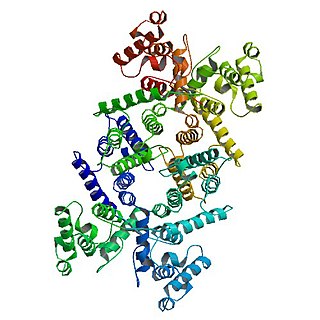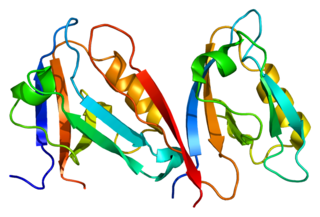Related Research Articles

Dystrophin is a rod-shaped cytoplasmic protein, and a vital part of a protein complex that connects the cytoskeleton of a muscle fiber to the surrounding extracellular matrix through the cell membrane. This complex is variously known as the costamere or the dystrophin-associated protein complex (DAPC). Many muscle proteins, such as α-dystrobrevin, syncoilin, synemin, sarcoglycan, dystroglycan, and sarcospan, colocalize with dystrophin at the costamere. It has a molecular weight of 427 kDa

Duchenne muscular dystrophy (DMD) is a severe type of muscular dystrophy predominantly affecting boys. The onset of muscle weakness typically begins around age four, with rapid progression. Initially, muscle loss occurs in the thighs and pelvis, extending to the arms, which can lead to difficulties in standing up. By the age of 12, most individuals with Duchenne muscular dystrophy are unable to walk. Affected muscles may appear larger due to an increase in fat content, and scoliosis is common. Some individuals may experience intellectual disability, and females carrying a single copy of the mutated gene may show mild symptoms.

Becker muscular dystrophy (BMD) is an X-linked recessive inherited disorder characterized by slowly progressing muscle weakness of the legs and pelvis. It is a type of dystrophinopathy. The cause is mutations and deletions in any of the 79 exons encoding the large dystrophin protein, essential for maintaining the muscle fiber's cell membrane integrity. Becker muscular dystrophy is related to Duchenne muscular dystrophy in that both result from a mutation in the dystrophin gene, however the hallmark of Becker is milder in-frame deletions. and hence has a milder course, with patients maintaining ambulation till 50–60 years if detected early.

Fukuyama congenital muscular dystrophy (FCMD) is a rare, autosomal recessive form of muscular dystrophy (weakness and breakdown of muscular tissue) mainly described in Japan but also identified in Turkish and Ashkenazi Jewish patients; fifteen cases were first described on 1960 by Dr. Yukio Fukuyama.
Derek Blake was, until 2007, the Isobel Laing Post-Doctoral Fellow in Biomedical Sciences, and the Wellcome Trust Senior Fellow in Basic Biomedical Science, Oriel College, Oxford.
The dystrophin-associated protein complex, also known as the dystrophin-associated glycoprotein complex is a multiprotein complex that includes dystrophin and the dystrophin-associated proteins. It is one of the two protein complexes that make up the costamere in striated muscle cells. The other complex is the integrin-vinculin-talin complex.

Utrophin is a protein that in humans is encoded by the UTRN gene. The name is a short form for ubiquitous dystrophin.

Sarcospan is a protein that in humans is encoded by the SSPN gene.
Dystrobrevin is a protein that binds to dystrophin in the costamere of skeletal muscle cells. In humans, there are at least two isoforms of dystrobrevin, dystrobrevin alpha and dystrobrevin beta.

Alpha-1-syntrophin is a protein that in humans is encoded by the SNTA1 gene. Alpha-1 syntrophin is a signal transducing adaptor protein and serves as a scaffold for various signaling molecules. Alpha-1 syntrophin contains a PDZ domain, two Pleckstrin homology domain and a 'syntrophin unique' domain.

Beta-sarcoglycan is a protein that in humans is encoded by the SGCB gene.

Beta-2-syntrophin is a protein that in humans is encoded by the SNTB2 gene.

Alpha-sarcoglycan is a protein that in humans is encoded by the SGCA gene.

Beta-1-syntrophin is a protein that in humans is encoded by the SNTB1 gene.

Dystrobrevin alpha is a protein that in humans is encoded by the DTNA gene.

Pikachurin, also known as AGRINL (AGRINL) and EGF-like, fibronectin type-III and laminin G-like domain-containing protein (EGFLAM), is a protein that in humans is encoded by the EGFLAM gene.

Dystrobrevin beta is a protein which in humans is encoded by the DTNB gene.
David S. Bredt is an American molecular neuroscientist.
Stanley C. Froehner is an American physiologist and biophysicist currently the UW Medicine Distinguished Professor at University of Washington and an Elected Fellow of the American Association for the Advancement of Science.
References
- ↑ Mungrue, Imran N.; Bredt, David S. "nNOS at a glance: implications for brain and brawn" (PDF).